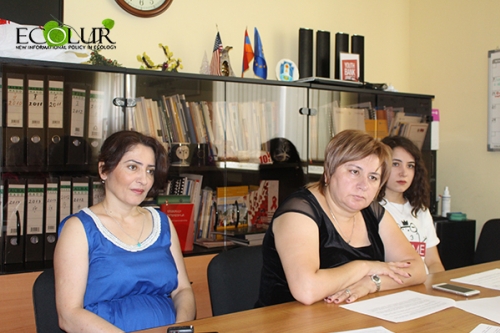

EcoLur
The Armenian Government is proposing to give a solution to the radioactive wastes and the problem of spent nuclear fuel at the Armenian Nuclear Power Plants through “Strategy for Safe Management of Radioactive Wastes and Spent Nuclear Fuel in the Republic of Armenia”. Society at large and the ANPP impacted zone population are worried about this problem and demand wide-scale public discussions.
According to the official information, ‘...Around 600 items of spent nuclear fuel were accumulated in the ANPP area before its relaunch in 1995. In 2000 French ‘Framatom’ organization constructed a burial facility for the long-term dry storage of wastes, where 616 items of spent nuclear fuel had been transferred by 2005. Each year the ANPP generates 80 items of spent nuclear fuel. The first part of the second stage designed for 672 items was completed and put into operation in spring 2008, which was filled in 2015. The first part of the spent nuclear fuel has been transferred into dry storage. The second part of the second stage of spent fuel dry storage construction was started in 2015 and currently is in operation designed for 672 items of spent nuclear fuel. It’s planned to fill 168 items of the spent nuclear fuel in the third stage by 2034 and then to construct the fourth one for 593 items of spent nuclear fuel, for which multiple-use containers will be used.
One of the main points in the strategy is the selection of the platform for the construction of a new burial facility for the ANPP. It’s proposed to examine the opportunities of deep burial of radioactive wastes in geological formations through conducting hydrological and geological examinations.’
In Anzhela Stepanyan’s opinion, President of “Armavir Press Club” NGO, this strategy is not clear for many citizens. “The nuclear power plant with its fuel, wastes and the radioactive background is a dark forest for the society, ask anyone you want. Even the people living nearby the nuclear power plant are not aware what kind of risks they deal with and how to protect from them. In the past, almost all the population and society in Metsamor received some information through the employees of the plant. Now the situation has changed, as most plant employees are from Yerevan. We need a professional expert group so as to have answers to certain questions. Unfortunately, we live in an active seismic zone, just in proximity to the nuclear power plant, and if we add unstable water resources and the burial facility of radioactive wastes, we will have the full image,” Angela Stepanyan said at the round table held at Armavir Development Center.
She drew special attention to the water problems related to the safety of the ANPP (note by EcoLur: the ANPP uses water from the Sev Jur river and 3 wells: the decrease in Sev Jur River is conditioned with the merciless use of groundwater by the fish farms located in Ararat Valley).
“Do we have now the Sevjur river? No, we don’t. And wherever we construct the burial facilities, there is a question arising: how will the society be protected? An environmental security matter also rises. The formulations in the strategy are not clear: how will the population be heard, what kind of methods will be used to ensure safety, whether or not there are special places for people in the villages nearby the plant? I can say for Armavir town that is nothing, an absolute zero,” Aznhela Stepanyan said.
Armavir Development Center Director Naira Araqelyan said the French and Japanese experts having visited their center assured them the radiation background of the environment is within the standards.
“Anyway, wide-scale public hearings shall be conducted in the region on this topic. Even if the radiation background is within the standard, it’s a fact that the US PeaceCorps volunteers are sent to our region because it’s considered to be a hazardous zone,” Naira Araqelyan said.
She also covered the matters of the ANPP social and corporate responsibility: whether there are social and environmental programs in the affected communities and whether these communities have any privileges in regard to the electricity price? “It’s important to make people aware, to hold public hearings and expert meetings. The people experience problems with irrigation water, which affects the cooling system of the nuclear power plant,” she said. Naira Araqelyan also attached much importance to officially recognizing communities located in a diameter of 10 km from the ANPP as impacted communities.



August 29, 2017 at 14:16
